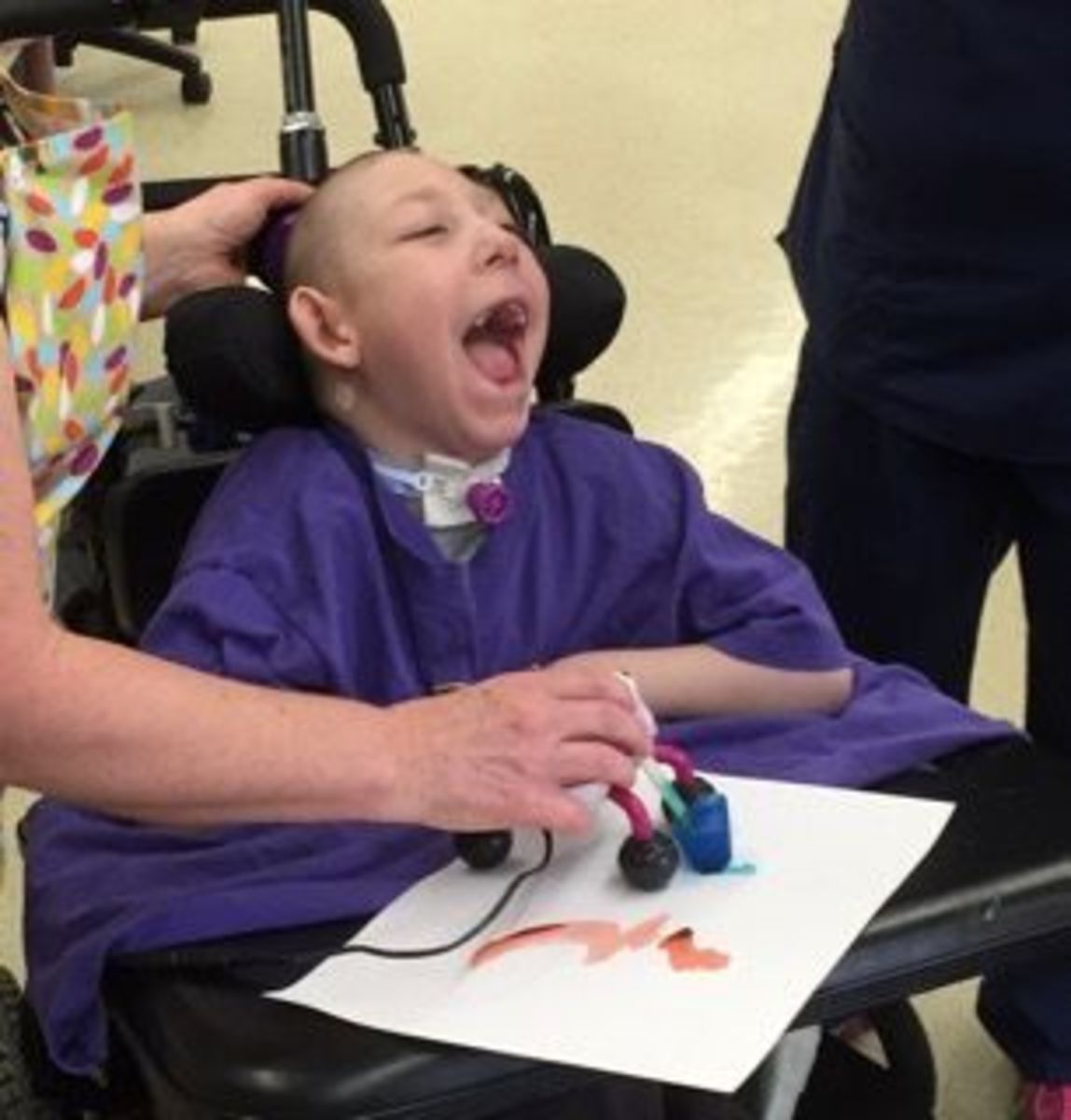Educational Strategies/Interventions for Students with Emotional and Behavioral Disorders
What to Do With Emotional and Behavioral Disorders in My Classroom

Emotional Disturbances and Characteristics of the Emotionally Distrurbed Student
Emotional Beheavioral Disordered children can be defined as having a condition which is marked by one or more characteristics in an inability to learn which is not explained by intellectual, sensory, or health factors; an inability to build or maintain satisfactory relationships with others; inappropriate behaviors during normal circumstances; pervasive moods (ie depression); and physical symptoms or fears (ie phobias).
Students with this disability often display Inappropriate behaviors during normal circumstances, inappropriate language and yelling, poor social skills, arguing, stealing, lying, destruction of personal property, lack of motivation, and poor self esteem. As a result, such behaviors can easily burn out any teacher. This being the case it is vital to not only the success of the student, but to the teachers as well to develop and maintain strategies which will have a profound effect on this population. First and foremost, one of the most important things to remember is what does this student need to be functional in society? This will be the question which guides the goals and strategies. Typically speaking, these students have very limited social and appropriate behavioral skills, therefore it may be important to focus on goals which will enable them to interact with others in an appropriate way (About.com, 2005). While is important that academic skills be taught, these students also need instruction in social skills, as this will transfer to various settings.
Additionally, I have found that these students thrive on positive reinforcement and positive verbal feedback, therefore it sis important for teachers to introduce and maintain this strategy to this population. Due to the fact that these students typically do not hear positive feedback at home, it proves to really be a boost to their pursuit of educational excellence.
How Ineffective Instruction Contributes to Behavior Problems and Holding Them Accountable For Their Behavior
One of the goals of education has always been to teach or instruct students in academic skills such as math, english, history, and science. However, today such skills are not the only things that teachers need to focus on when working with students. In fact, students in schools today have needs which were once primarily served in the home. Due to this, it has now become a focal point for teachers and schools to educate students on more than just academics (Kauffman, 2005).
One of the biggest problems with instruction in schools today is the fact that many teachers fail to realize that they need to teach students skills which will enable them to interact with others appropriately. Many students come to school with a lack of structure or discipline in the home or better yet, little instruction in appropriate socialization skills (Kauffman, 2005). That being said, it is often a forgotten part of the education process to provide such instruction to this underprivileged group.
In addition to that, many schools have really not adopted a system of rewarding positive behaviors and providing consequences for undesirable behaviors (Kauffman, 2005). Students need to be rewarded for appropriate behaviors when they are displayed to show them that they are doing what is socially acceptable and at the same time they need to know that when they do mess up there will be immediate consequences. Too often a student will act up and then get away with it, thus this continues the behavior (students generally will equate this to attention even if it is negative) (Incredible Horizons, 2005). The same holds true for when they do what is right and do not get praise for doing so. If you are not told that what you are doing is appropriate chances are you will fall into the trap of performing negative behaviors. As suggested (Incredible Horizons, 2005) direct instruction in social skills is essential to building appropriate and lasting relationships in the future.
Assiging Consequences and Holding Them Accountable
Students need consequences when they perform behaviors which are not appropriate. A student needs to know that when he or she acts out that there will consequences that follow. If this is not done the likelihood that the student will repeat that behavior increases. However, I must note that students with emotional and behavioral disorders also are more respectful of the teacher who provides structure through consistent discipline and routines. In my experience I have seen how such structure makes then student more likely to respect you for that. The fact that many of these students come from homes where a lack of structure is given leads to problems in both the home and the school. Students thrive on environments where rules and expectations are enforced (Kauffman, 2005) and when it is not given they will tend to create their own routine. For that reason alone, it is necessary for educators to hold these students responsible for their inappropriate behaviors.
At the same time, an educator can hold a student responsible for their behaviors in a manner which is not likely to reproduce the behavior over and over. Teachers need to be consistent in their expectations and hold all students accountable. It is not wise to enforce the rules with one student and then turn around and not expect the same out of another student. Not only that, but teachers need to show the student that they mean business and explain that if a certain behavior occur they will receive a consequence as a result of that behavior. In turn, if they do well they will receive positive rewards.
Educator Insensitivities to Individual Differences in Students and How This Contributes to Behaviors in the Classroom
Educators oftentimes are too quick to assume that all students learn in the same manner, therefore the disregard how a student may be different from his or her peer. Students with or without disabilities learn in different ways and this is something which is not taken into consideration when planning and working with students. While one student may learn best auditorily, another may learn better through hands on activities. Teachers need to be more sensitive to the needs of the students that they work with and take into consideration their strengths and multiple intelligences (Kauffman, 2005).
In addition to that, many teachers fail to realize or perhaps think about the impact that the home environment has on the child. Students all come from different backgrounds (including cultural and socioeconomic) and this is something which can greatly impact education (Kauffman, 2005). If a student comes to school having had little to eat that morning chances are that the student will have problems in school that day. This is where teachers need to be effective at recognizing such issues to head off problem behaviors. Simply knowing that a student has had problems at home before coming to school can save problems at school. That is where teachers can be more proactive when looking at how certain circumstances affect individuals in different ways. On a personal note I have seen how something which seems like such a small issue to us is really a big issue to the student. When I see one of my students come into school looking like they have had a bad morning I will speak with the student even before the day has begun. Generally doing this really staves off the student having a bad day and earns you respect with that student.
Self Advocacy
One of the biggest concerns of teachers with students with disabilities centers on the fact that these students typically suffer from lower levels of self esteem and self advocacy skills than students in the general population. As a teacher of these students I can attest to the fact that this is an adequate observation. It is not uncommon that these students simply believe that because they have a disability they are limited in what they can do and likewise will not advocate for themselves even if they are right. However, what teachers need to do is help these students understand that they are capable of achieving goals that they set for themselves and that they need to be able to advocate for their rights in society. One way this can be done is to provide real life examples and instruction in self advocacy skills by doing mock scenarios. Students in this situation do not respond well to lectures on this, therefore real life scenarios would be more appropriate. In addition to that, promoting independence in these students will indeed help them feel more confident in their selves, leading to increased levels of self esteem. Students with disabilities need to be aware of the fact that they will not always have someone looking over their shoulder, therefore they need to develop a sense of independence in order to better achieve more confidence in what they are doing.
It is my belief that all students should learn how to respect others regardless of their own beliefs and opinions of other people. That being said, one of my goals as a teacher is to promote a classroom where mutual respect and cooperation are encouraged. Students with and without disabilkities need to be able to understand and interact appropriately with everyone within a classroom, not just who they choose to be appropriate with. One of the ways that this can be accomplished is via consistent adherence to the rules and respect for what others are saying, even if they are wrong. I have seen many instances where students will make fun of another student just because they do not like what that student has said. My response to such behavior is to correct the behavior and teach the student that everyone is
entitled to his or her opinions. Students of all levels need to be able to get along with others and respect them for what they can bring to a situation and not what they lack. It should also be known that teachers should avoid passing their own judgment on someone as this will oftentimes transfer to the students in the classroom. Teachers serve as role models for students, therefore their behavior needs to be appropriate as well. If you as a teacher criticize others, what do you think your students will do?
Educational Strategies Teachers Can Encourage
I. Plan for structured classroom activities which promote movement in the classroom.
Vary the way instruction is delivered in the classroom. Instead of focusing solely on seat related activities, develop work stations and collaborative learning centers that focus on the lesson being taught. Students thrive when they are given the opportunity to apply what they are learning in a hands on approach. In addition to that, this allows for structured opportunities for the student who has a need to move about the room
II. Allow students to take frequent breaks
Students with emotional and behavioral disorders have difficulty staying on a task for long periods of time, especially if the class period is 40 minutes in duration. Therefore, educators should give these students frequent breaks from a task. Frequent breaks, however, do not have to be unstructured. Instead, teachers can allow students to take something to the office, take a note to another teacher, or simply allowed to get up to sharpen their pencil (or go to the bathroom).
III. Assign classroom responsibilities which allow movement and promote responsibility
Educators can effectively structure movement for students with emotional and behavioral disorders by assigning classroom duties for the students. Setting up a schedule that assigns each student a classroom job not only allows for structured movement, but also helps develop a sense of responsibility. This also promotes a sense of belonging to the classroom community and develops characateristics such as self esteem, responsibility and mutual respect for one another.
Educational Resources for Teachers
Discipline Help
Other Resources
Brock, S. (1998). Strategies for teachers. Retrieved at http://www.ldonline.org/ld_indepth/teachers/nasp_adhdclsrm.html
Cardman, S. (1994). Checklist for classroom teachers. Retrieved at http://www.newideas.net/p0000570.htm
Child Development Institute (2005). Suggested classroom intervention for children with add and learning disabilities. Retrieved at http://www.childdevelopmentinfo.com/learning/teacher.shtml
West, K. (2000). Classroom tips for your add child. Retrieved at http://www.lessontutor.com/kw2.html







